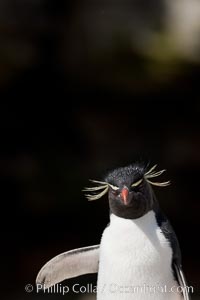
Rockhopper penguins, on rocky coastline of New Island in the Falklands. True to their name, rockhopper penguins scramble over the rocky intertidal zone and up steep hillsides to reach their nesting colonies which may be hundreds of feet above the ocean, often jumping up and over rocks larger than themselves. Rockhopper penguins reach 23" and 7.5lb in size, and can live 20-30 years. They feed primarily on feed on krill, squid, octopus, lantern fish, molluscs, plankton, cuttlefish, and crustaceans.
Species: Rockhopper penguin, Western rockhopper penguin, Eudyptes chrysocome, Eudyptes chrysocome chrysocome
Location: New Island, Falkland Islands, United Kingdom
Image ID: 23747
Species: Rockhopper penguin, Western rockhopper penguin, Eudyptes chrysocome, Eudyptes chrysocome chrysocome
Location: New Island, Falkland Islands, United Kingdom
Image ID: 23747

Rockhopper penguins, on rocky coastline of New Island in the Falklands. True to their name, rockhopper penguins scramble over the rocky intertidal zone and up steep hillsides to reach their nesting colonies which may be hundreds of feet above the ocean, often jumping up and over rocks larger than themselves. Rockhopper penguins reach 23" and 7.5lb in size, and can live 20-30 years. They feed primarily on feed on krill, squid, octopus, lantern fish, molluscs, plankton, cuttlefish, and crustaceans.
Species: Rockhopper penguin, Western rockhopper penguin, Eudyptes chrysocome, Eudyptes chrysocome chrysocome
Location: New Island, Falkland Islands, United Kingdom
Image ID: 23741
Species: Rockhopper penguin, Western rockhopper penguin, Eudyptes chrysocome, Eudyptes chrysocome chrysocome
Location: New Island, Falkland Islands, United Kingdom
Image ID: 23741

Rockhopper penguins, on rocky coastline of New Island in the Falklands. True to their name, rockhopper penguins scramble over the rocky intertidal zone and up steep hillsides to reach their nesting colonies which may be hundreds of feet above the ocean, often jumping up and over rocks larger than themselves. Rockhopper penguins reach 23" and 7.5lb in size, and can live 20-30 years. They feed primarily on feed on krill, squid, octopus, lantern fish, molluscs, plankton, cuttlefish, and crustaceans.
Species: Rockhopper penguin, Western rockhopper penguin, Eudyptes chrysocome, Eudyptes chrysocome chrysocome
Location: New Island, Falkland Islands, United Kingdom
Image ID: 23743
Species: Rockhopper penguin, Western rockhopper penguin, Eudyptes chrysocome, Eudyptes chrysocome chrysocome
Location: New Island, Falkland Islands, United Kingdom
Image ID: 23743

Visitors to New Island, in the Falkland Islands view rockhopper penguins coming and going along the rocky intertidal zone.
Species: Rockhopper penguin, Western rockhopper penguin, Eudyptes chrysocome, Eudyptes chrysocome chrysocome
Location: New Island, Falkland Islands, United Kingdom
Image ID: 23745
Species: Rockhopper penguin, Western rockhopper penguin, Eudyptes chrysocome, Eudyptes chrysocome chrysocome
Location: New Island, Falkland Islands, United Kingdom
Image ID: 23745

Rockhopper penguin. This juvenile has not yet developed the yellowish plume feathers that extend behind its red eye in adults. The western rockhopper penguin stands about 23" high and weights up to 7.5 lb, with a lifespan of 20-30 years.
Species: Rockhopper penguin, Western rockhopper penguin, Eudyptes chrysocome, Eudyptes chrysocome chrysocome
Location: New Island, Falkland Islands, United Kingdom
Image ID: 23733
Species: Rockhopper penguin, Western rockhopper penguin, Eudyptes chrysocome, Eudyptes chrysocome chrysocome
Location: New Island, Falkland Islands, United Kingdom
Image ID: 23733

Rockhopper penguin. This juvenile has not yet developed the yellowish plume feathers that extend behind its red eye in adults. The western rockhopper penguin stands about 23" high and weights up to 7.5 lb, with a lifespan of 20-30 years.
Species: Rockhopper penguin, Western rockhopper penguin, Eudyptes chrysocome, Eudyptes chrysocome chrysocome
Location: New Island, Falkland Islands, United Kingdom
Image ID: 23734
Species: Rockhopper penguin, Western rockhopper penguin, Eudyptes chrysocome, Eudyptes chrysocome chrysocome
Location: New Island, Falkland Islands, United Kingdom
Image ID: 23734

Rockhopper penguin portrait, showing the yellowish plume feathers that extend behind its red eye in adults. The western rockhopper penguin stands about 23" high and weights up to 7.5 lb, with a lifespan of 20-30 years.
Species: Rockhopper penguin, Western rockhopper penguin, Eudyptes chrysocome, Eudyptes chrysocome chrysocome
Location: New Island, Falkland Islands, United Kingdom
Image ID: 23735
Species: Rockhopper penguin, Western rockhopper penguin, Eudyptes chrysocome, Eudyptes chrysocome chrysocome
Location: New Island, Falkland Islands, United Kingdom
Image ID: 23735

Rockhopper penguin portrait, showing the yellowish plume feathers that extend behind its red eye in adults. The western rockhopper penguin stands about 23" high and weights up to 7.5 lb, with a lifespan of 20-30 years.
Species: Rockhopper penguin, Western rockhopper penguin, Eudyptes chrysocome, Eudyptes chrysocome chrysocome
Location: New Island, Falkland Islands, United Kingdom
Image ID: 23736
Species: Rockhopper penguin, Western rockhopper penguin, Eudyptes chrysocome, Eudyptes chrysocome chrysocome
Location: New Island, Falkland Islands, United Kingdom
Image ID: 23736
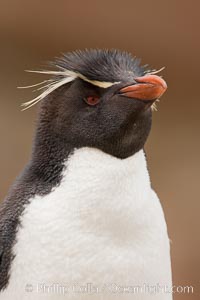
Rockhopper penguin portrait, showing the yellowish plume feathers that extend behind its red eye in adults. The western rockhopper penguin stands about 23" high and weights up to 7.5 lb, with a lifespan of 20-30 years.
Species: Rockhopper penguin, Western rockhopper penguin, Eudyptes chrysocome, Eudyptes chrysocome chrysocome
Location: New Island, Falkland Islands, United Kingdom
Image ID: 23737
Species: Rockhopper penguin, Western rockhopper penguin, Eudyptes chrysocome, Eudyptes chrysocome chrysocome
Location: New Island, Falkland Islands, United Kingdom
Image ID: 23737

Rockhopper penguin portrait, showing the yellowish plume feathers that extend behind its red eye in adults. The western rockhopper penguin stands about 23" high and weights up to 7.5 lb, with a lifespan of 20-30 years.
Species: Rockhopper penguin, Western rockhopper penguin, Eudyptes chrysocome, Eudyptes chrysocome chrysocome
Location: New Island, Falkland Islands, United Kingdom
Image ID: 23738
Species: Rockhopper penguin, Western rockhopper penguin, Eudyptes chrysocome, Eudyptes chrysocome chrysocome
Location: New Island, Falkland Islands, United Kingdom
Image ID: 23738
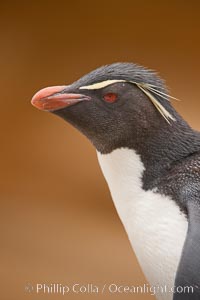
Rockhopper penguin portrait, showing the yellowish plume feathers that extend behind its red eye in adults. The western rockhopper penguin stands about 23" high and weights up to 7.5 lb, with a lifespan of 20-30 years.
Species: Rockhopper penguin, Western rockhopper penguin, Eudyptes chrysocome, Eudyptes chrysocome chrysocome
Location: New Island, Falkland Islands, United Kingdom
Image ID: 23739
Species: Rockhopper penguin, Western rockhopper penguin, Eudyptes chrysocome, Eudyptes chrysocome chrysocome
Location: New Island, Falkland Islands, United Kingdom
Image ID: 23739

Rockhopper penguin portrait, showing the yellowish plume feathers that extend behind its red eye in adults. The western rockhopper penguin stands about 23" high and weights up to 7.5 lb, with a lifespan of 20-30 years.
Species: Rockhopper penguin, Western rockhopper penguin, Eudyptes chrysocome, Eudyptes chrysocome chrysocome
Location: New Island, Falkland Islands, United Kingdom
Image ID: 23740
Species: Rockhopper penguin, Western rockhopper penguin, Eudyptes chrysocome, Eudyptes chrysocome chrysocome
Location: New Island, Falkland Islands, United Kingdom
Image ID: 23740

Rockhopper penguins, on rocky coastline of New Island in the Falklands. True to their name, rockhopper penguins scramble over the rocky intertidal zone and up steep hillsides to reach their nesting colonies which may be hundreds of feet above the ocean, often jumping up and over rocks larger than themselves. Rockhopper penguins reach 23" and 7.5lb in size, and can live 20-30 years. They feed primarily on feed on krill, squid, octopus, lantern fish, molluscs, plankton, cuttlefish, and crustaceans.
Species: Rockhopper penguin, Western rockhopper penguin, Eudyptes chrysocome, Eudyptes chrysocome chrysocome
Location: New Island, Falkland Islands, United Kingdom
Image ID: 23748
Species: Rockhopper penguin, Western rockhopper penguin, Eudyptes chrysocome, Eudyptes chrysocome chrysocome
Location: New Island, Falkland Islands, United Kingdom
Image ID: 23748

Rockhopper penguins, on rocky coastline of New Island in the Falklands. True to their name, rockhopper penguins scramble over the rocky intertidal zone and up steep hillsides to reach their nesting colonies which may be hundreds of feet above the ocean, often jumping up and over rocks larger than themselves. Rockhopper penguins reach 23" and 7.5lb in size, and can live 20-30 years. They feed primarily on feed on krill, squid, octopus, lantern fish, molluscs, plankton, cuttlefish, and crustaceans.
Species: Rockhopper penguin, Western rockhopper penguin, Eudyptes chrysocome, Eudyptes chrysocome chrysocome
Location: New Island, Falkland Islands, United Kingdom
Image ID: 23749
Species: Rockhopper penguin, Western rockhopper penguin, Eudyptes chrysocome, Eudyptes chrysocome chrysocome
Location: New Island, Falkland Islands, United Kingdom
Image ID: 23749

Rockhopper penguins, on rocky coastline of New Island in the Falklands. True to their name, rockhopper penguins scramble over the rocky intertidal zone and up steep hillsides to reach their nesting colonies which may be hundreds of feet above the ocean, often jumping up and over rocks larger than themselves. Rockhopper penguins reach 23" and 7.5lb in size, and can live 20-30 years. They feed primarily on feed on krill, squid, octopus, lantern fish, molluscs, plankton, cuttlefish, and crustaceans.
Species: Rockhopper penguin, Western rockhopper penguin, Eudyptes chrysocome, Eudyptes chrysocome chrysocome
Location: New Island, Falkland Islands, United Kingdom
Image ID: 23750
Species: Rockhopper penguin, Western rockhopper penguin, Eudyptes chrysocome, Eudyptes chrysocome chrysocome
Location: New Island, Falkland Islands, United Kingdom
Image ID: 23750

Rockhopper penguins, on rocky coastline of New Island in the Falklands. True to their name, rockhopper penguins scramble over the rocky intertidal zone and up steep hillsides to reach their nesting colonies which may be hundreds of feet above the ocean, often jumping up and over rocks larger than themselves. Rockhopper penguins reach 23" and 7.5lb in size, and can live 20-30 years. They feed primarily on feed on krill, squid, octopus, lantern fish, molluscs, plankton, cuttlefish, and crustaceans.
Species: Rockhopper penguin, Western rockhopper penguin, Eudyptes chrysocome, Eudyptes chrysocome chrysocome
Location: New Island, Falkland Islands, United Kingdom
Image ID: 23751
Species: Rockhopper penguin, Western rockhopper penguin, Eudyptes chrysocome, Eudyptes chrysocome chrysocome
Location: New Island, Falkland Islands, United Kingdom
Image ID: 23751

Rockhopper penguins, on rocky coastline of New Island in the Falklands. True to their name, rockhopper penguins scramble over the rocky intertidal zone and up steep hillsides to reach their nesting colonies which may be hundreds of feet above the ocean, often jumping up and over rocks larger than themselves. Rockhopper penguins reach 23" and 7.5lb in size, and can live 20-30 years. They feed primarily on feed on krill, squid, octopus, lantern fish, molluscs, plankton, cuttlefish, and crustaceans.
Species: Rockhopper penguin, Western rockhopper penguin, Eudyptes chrysocome, Eudyptes chrysocome chrysocome
Location: New Island, Falkland Islands, United Kingdom
Image ID: 23746
Species: Rockhopper penguin, Western rockhopper penguin, Eudyptes chrysocome, Eudyptes chrysocome chrysocome
Location: New Island, Falkland Islands, United Kingdom
Image ID: 23746
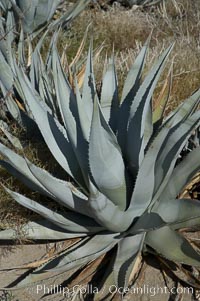
Desert agave, also known as the Century Plant, blooms in spring in Anza-Borrego Desert State Park. Desert agave is the only agave species to be found on the rocky slopes and flats bordering the Coachella Valley. It occurs over a wide range of elevations from 500 to over 4,000. It is called century plant in reference to the amount of time it takes it to bloom. This can be anywhere from 5 to 20 years. They send up towering flower stalks that can approach 15 feet in height. Sending up this tremendous display attracts a variety of pollinators including bats, hummingbirds, bees, moths and other insects and nectar-eating birds.
Species: Desert agave, Agave deserti
Image ID: 11552
Species: Desert agave, Agave deserti
Image ID: 11552
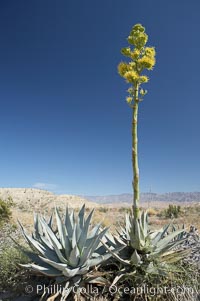
Desert agave, also known as the Century Plant, blooms in spring in Anza-Borrego Desert State Park. Desert agave is the only agave species to be found on the rocky slopes and flats bordering the Coachella Valley. It occurs over a wide range of elevations from 500 to over 4,000. It is called century plant in reference to the amount of time it takes it to bloom. This can be anywhere from 5 to 20 years. They send up towering flower stalks that can approach 15 feet in height. Sending up this tremendous display attracts a variety of pollinators including bats, hummingbirds, bees, moths and other insects and nectar-eating birds.
Species: Desert agave, Agave deserti
Image ID: 11553
Species: Desert agave, Agave deserti
Image ID: 11553
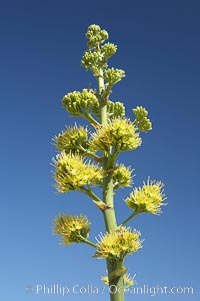
Desert agave, also known as the Century Plant, blooms in spring in Anza-Borrego Desert State Park. Desert agave is the only agave species to be found on the rocky slopes and flats bordering the Coachella Valley. It occurs over a wide range of elevations from 500 to over 4,000. It is called century plant in reference to the amount of time it takes it to bloom. This can be anywhere from 5 to 20 years. They send up towering flower stalks that can approach 15 feet in height. Sending up this tremendous display attracts a variety of pollinators including bats, hummingbirds, bees, moths and other insects and nectar-eating birds.
Species: Desert agave, Agave deserti
Image ID: 11554
Species: Desert agave, Agave deserti
Image ID: 11554
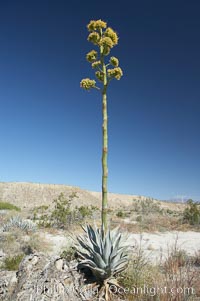
Desert agave, also known as the Century Plant, blooms in spring in Anza-Borrego Desert State Park. Desert agave is the only agave species to be found on the rocky slopes and flats bordering the Coachella Valley. It occurs over a wide range of elevations from 500 to over 4,000. It is called century plant in reference to the amount of time it takes it to bloom. This can be anywhere from 5 to 20 years. They send up towering flower stalks that can approach 15 feet in height. Sending up this tremendous display attracts a variety of pollinators including bats, hummingbirds, bees, moths and other insects and nectar-eating birds.
Species: Desert agave, Agave deserti
Image ID: 11555
Species: Desert agave, Agave deserti
Image ID: 11555
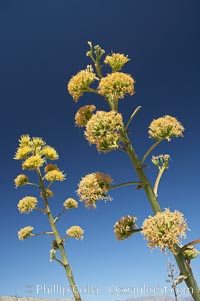
Desert agave, also known as the Century Plant, blooms in spring in Anza-Borrego Desert State Park. Desert agave is the only agave species to be found on the rocky slopes and flats bordering the Coachella Valley. It occurs over a wide range of elevations from 500 to over 4,000. It is called century plant in reference to the amount of time it takes it to bloom. This can be anywhere from 5 to 20 years. They send up towering flower stalks that can approach 15 feet in height. Sending up this tremendous display attracts a variety of pollinators including bats, hummingbirds, bees, moths and other insects and nectar-eating birds.
Species: Desert agave, Agave deserti
Image ID: 11556
Species: Desert agave, Agave deserti
Image ID: 11556
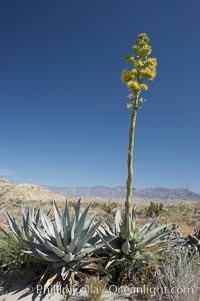
Desert agave, also known as the Century Plant, blooms in spring in Anza-Borrego Desert State Park. Desert agave is the only agave species to be found on the rocky slopes and flats bordering the Coachella Valley. It occurs over a wide range of elevations from 500 to over 4,000. It is called century plant in reference to the amount of time it takes it to bloom. This can be anywhere from 5 to 20 years. They send up towering flower stalks that can approach 15 feet in height. Sending up this tremendous display attracts a variety of pollinators including bats, hummingbirds, bees, moths and other insects and nectar-eating birds.
Species: Desert agave, Agave deserti
Image ID: 11557
Species: Desert agave, Agave deserti
Image ID: 11557
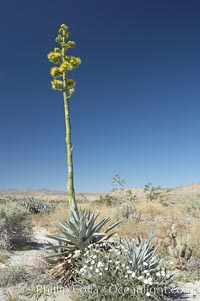
Desert agave, also known as the Century Plant, blooms in spring in Anza-Borrego Desert State Park. Desert agave is the only agave species to be found on the rocky slopes and flats bordering the Coachella Valley. It occurs over a wide range of elevations from 500 to over 4,000. It is called century plant in reference to the amount of time it takes it to bloom. This can be anywhere from 5 to 20 years. They send up towering flower stalks that can approach 15 feet in height. Sending up this tremendous display attracts a variety of pollinators including bats, hummingbirds, bees, moths and other insects and nectar-eating birds.
Species: Desert agave, Agave deserti
Image ID: 11558
Species: Desert agave, Agave deserti
Image ID: 11558
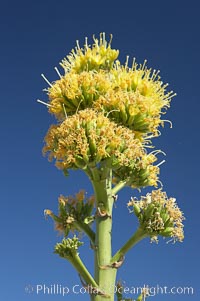
Desert agave, also known as the Century Plant, blooms in spring in Anza-Borrego Desert State Park. Desert agave is the only agave species to be found on the rocky slopes and flats bordering the Coachella Valley. It occurs over a wide range of elevations from 500 to over 4,000. It is called century plant in reference to the amount of time it takes it to bloom. This can be anywhere from 5 to 20 years. They send up towering flower stalks that can approach 15 feet in height. Sending up this tremendous display attracts a variety of pollinators including bats, hummingbirds, bees, moths and other insects and nectar-eating birds.
Species: Desert agave, Agave deserti
Image ID: 11559
Species: Desert agave, Agave deserti
Image ID: 11559
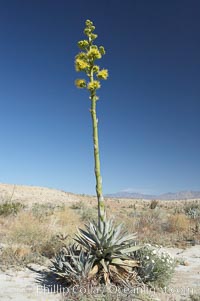
Desert agave, also known as the Century Plant, blooms in spring in Anza-Borrego Desert State Park. Desert agave is the only agave species to be found on the rocky slopes and flats bordering the Coachella Valley. It occurs over a wide range of elevations from 500 to over 4,000. It is called century plant in reference to the amount of time it takes it to bloom. This can be anywhere from 5 to 20 years. They send up towering flower stalks that can approach 15 feet in height. Sending up this tremendous display attracts a variety of pollinators including bats, hummingbirds, bees, moths and other insects and nectar-eating birds.
Species: Desert agave, Agave deserti
Image ID: 11560
Species: Desert agave, Agave deserti
Image ID: 11560
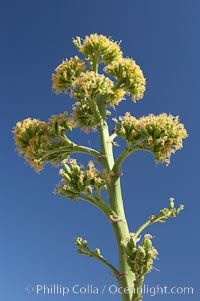
Desert agave, also known as the Century Plant, blooms in spring in Anza-Borrego Desert State Park. Desert agave is the only agave species to be found on the rocky slopes and flats bordering the Coachella Valley. It occurs over a wide range of elevations from 500 to over 4,000. It is called century plant in reference to the amount of time it takes it to bloom. This can be anywhere from 5 to 20 years. They send up towering flower stalks that can approach 15 feet in height. Sending up this tremendous display attracts a variety of pollinators including bats, hummingbirds, bees, moths and other insects and nectar-eating birds.
Species: Desert agave, Agave deserti
Image ID: 11561
Species: Desert agave, Agave deserti
Image ID: 11561
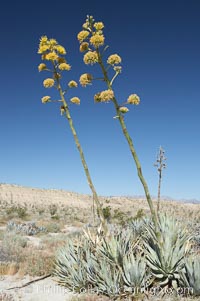
Desert agave, also known as the Century Plant, blooms in spring in Anza-Borrego Desert State Park. Desert agave is the only agave species to be found on the rocky slopes and flats bordering the Coachella Valley. It occurs over a wide range of elevations from 500 to over 4,000. It is called century plant in reference to the amount of time it takes it to bloom. This can be anywhere from 5 to 20 years. They send up towering flower stalks that can approach 15 feet in height. Sending up this tremendous display attracts a variety of pollinators including bats, hummingbirds, bees, moths and other insects and nectar-eating birds.
Species: Desert agave, Agave deserti
Image ID: 11562
Species: Desert agave, Agave deserti
Image ID: 11562
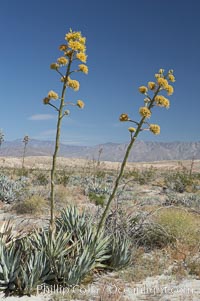
Desert agave, also known as the Century Plant, blooms in spring in Anza-Borrego Desert State Park. Desert agave is the only agave species to be found on the rocky slopes and flats bordering the Coachella Valley. It occurs over a wide range of elevations from 500 to over 4,000. It is called century plant in reference to the amount of time it takes it to bloom. This can be anywhere from 5 to 20 years. They send up towering flower stalks that can approach 15 feet in height. Sending up this tremendous display attracts a variety of pollinators including bats, hummingbirds, bees, moths and other insects and nectar-eating birds.
Species: Desert agave, Agave deserti
Image ID: 11563
Species: Desert agave, Agave deserti
Image ID: 11563
